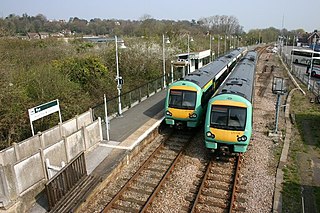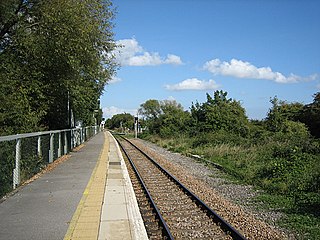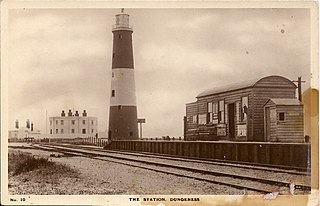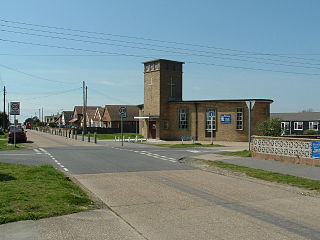
The Romney, Hythe and Dymchurch Railway (RH&DR) is a 15 in gauge light railway in Kent, England, operating steam and internal combustion locomotives. The 13+1⁄2-mile (21.7 km) line runs from the Cinque Port of Hythe via Dymchurch, St. Mary's Bay, New Romney and Romney Sands to Dungeness, close to the Dungeness nuclear power stations and Dungeness Lighthouse. The line is double track north of New Romney and single track south.

Romney Marsh is a sparsely populated wetland area in the counties of Kent and East Sussex in the south-east of England. It covers about 100 square miles (260 km2). The Marsh has been in use for centuries, though its inhabitants commonly suffered from malaria until the 18th century. Due to its location, geography and isolation, it was important for smugglers between the 17th and 19th centuries. The area has long been used for sheep pasture: Romney Marsh sheep are considered one of the most successful and important sheep breeds. Featuring numerous waterways, and with some areas lying below sea level, the Marsh has over time sustained a gradual level of reclamation, both through natural causes and by human intervention.

New Romney is a market town in Kent, England, on the edge of Romney Marsh, an area of flat, rich agricultural land reclaimed from the sea after the harbour began to silt up. New Romney, one of the original Cinque Ports, was once a sea port, with the harbour adjacent to the church, but is now more than a mile from the sea. It is the headquarters of the Romney, Hythe and Dymchurch Railway.

Lydd is a town and electoral ward in Kent, England, lying on Romney Marsh. It is one of the larger settlements on the marsh, and the most southerly town in Kent. Lydd reached the height of its prosperity during the 13th century, when it was a corporate member of the Cinque Ports, a "limb" of Romney. Located on Denge Marsh, Lydd was one of the first sandy islands to form as the bay filled in and evolved into what is now called Romney Marsh.

Dungeness is a headland on the coast of Kent, England, formed largely of a shingle beach in the form of a cuspate foreland. It shelters a large area of low-lying land, Romney Marsh. Dungeness spans Dungeness Nuclear Power Station, the hamlet of Dungeness, and an ecological site at the same location. It lies within the civil parish of Lydd.

The Marshlink line is a railway line in South East England. It runs from Ashford, Kent via Romney Marsh, Rye and the Ore Tunnel to Hastings where it connects to the East Coastway line towards Eastbourne and Brighton.

Winchelsea railway station is a railway station in East Sussex, England. It is about 0.62 miles (1 km) from Winchelsea and is actually in the neighbouring parish of Udimore. It is on the Marshlink line 9.3 miles (15 km) north east of Hastings, and train services are provided by Southern. The station originally had two platforms, but in 1979, the line was singled and only the up platform is now in use. The former down platform and station building are now converted to a private house.

Rye railway station is a Grade II listed station, serving Rye, East Sussex, England. It is on the Marshlink line between Hastings and Ashford International and is the principal station between those two terminals. The station is a passing place between two single-track sections. Services are provided by Southern, usually between Eastbourne and Ashford.

Appledore railway station is a Grade II listed station east of Appledore in Kent, England. It is on the Marshlink line, and train services are provided by Southern.

Ham Street railway station is a Grade II listed stop on the Marshlink line in the village of Hamstreet, Kent, between Ashford International and Hastings. Services are provided by Southern.

Tongham railway station was a railway station serving the village of Tongham, Guildford, Surrey in England which opened in 1856 and closed in 1937.

Dungeness was a railway station which served the Dungeness headland in Kent, England. Opened in 1883 by the Lydd Railway Company, it closed to passengers in 1937. Part of the line which served the station is converted to the main access road as a means of transporting atomic waste from nearby Dungeness nuclear power station.

Greatstone is a village on the coast of Romney Marsh in Kent, England. It is east of the town of New Romney and split between the civil parishes of New Romney and Lydd.

The Hawkhurst branch line was a short railway line in Kent that connected Hawkhurst, Cranbrook, Goudhurst and Horsmonden with the town of Paddock Wood and the South Eastern and Medway Valley lines, a distance of 11 miles 24 chains.

Lydd Town was a railway station which served the town of Lydd in Kent, England. Opened on 7 December 1881 by the Lydd Railway Company. It closed to passengers in 1967 but the line through the station remained open for freight.

Brookland Halt was a railway station which served the village of Brookland in Kent, England. The station opened in 1881 and closed in 1967.

Lydd-on-Sea Halt was a railway station which served the modern village of Lydd-on-Sea in Kent, England. The station opened in 1937 and closed in 1967.

Greatstone-on-Sea Halt was a railway station which served the modern village of Greatstone-on-Sea in Kent, England. The station opened in 1937 and closed in 1967.

Dungeness Lifeboat Station is located on Dungeness Road, about 3.5 miles (5.6 km) south-east of the town of Lydd, on the cuspate foreland of Dungeness, on the Kent coast.
Littlestone-on-Sea Lifeboat Station is located on Coast Drive, actually at Greatstone-on-Sea, approximately 1.5 miles (2.4 km) south east of New Romney, on the Kent coast.





















